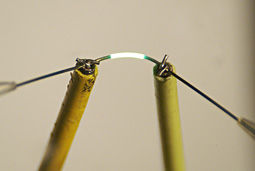
“That is why we tried to use glass fibres for our first trials,” Tobias Könyves-Toth continues, “because they have a very smooth surface.” But glass fibres are also brittle, and are not suitable for weaving textiles. Therefore the people at the TU are now carrying out trials with polymer-coated glass fibres. The aim is to utilize the polymer fibre coating to smoothen the fibre surface for a successful subsequent coating with organic semiconductor elements and finally provide flexibility to be woven in the textile.
Tobias Könyves-Toth started with a fibre of 1 mm thickness and things have moved on quite satisfactorily. “Today we have even been able to get a 500 micrometre fibre to glow at 5 millimetres,” he is delighted to report. “And even if the fibre has been bent, the OLEDs still work.”
However, although the trials have been a great success, there is still some way to go before smart textiles are reality. The lifetime of the electric functionality is limited. There is as yet no solution for a protective layer to protect the organic semiconductor molecules against oxygen and moisture.
The glowing fibres are yet to be able to cope with the mechanical loads that occur during the weaving process and when the garments are worn. Picture: Katrin Binner
Although first attempts have been made, it is going to take some time before the process is ready for the market. And the fibres that have been used so far are still too brittle and too thick to be woven into textiles. Nor are the glowing fibres able to cope with the mechanical loads that occur during the weaving process and when the garments are worn.
The scientists at Darmstadt are now looking into patent registration. The textiles industry has shown much interest in their development, as
Professor von Seggern and Tobias Könyves-Toth found in Greece at the beginning of July, when they presented their process at the International Symposium on Flexible Organic Solutions (ISFOE 13).
There may still be much to do, but the first steps have been taken towards the reproducible and controllable production of smart textiles – and there is almost no limit to the possible applications. “The only limit that does exist is our own imagination,” Tobias Könyves-Toth sums up.
Technische Universität Darmstadt

